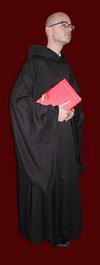Monk
|
|
A monk is a person who practices monasticism, adopting a strict religious and ascetic lifestyle, usually in community with others following the same path. The word comes from the Greek monachos (μοναχός), commonly translated as a solitary person and can apply to either men or women.
It should be noted, however, that monachos is a word that had to be forged especially to name the then new phenomenon of men living solitarily in the Egyptian desert. The phenomenon came to an abrupt rise in the 3rd century AD, when thousands of Egyptians, mostly men, set out to the deserts of Nitria, southwest of the city of Alexandria, in order to imitate the life of St. Anthony, the first Christian monk.
Monks usually live in a monastery following a single rule and governed by an abbot. Monasteries can be organized as Cenobiums, where all live together, pray together, and share everything; or they can be more disjointed with the monks only coming together for Sunday services. A monk who lives alone, away from society and sometimes also from all other monks, is called an Anchorite or Hesicaste (also called a hermit).
The female ascetic is usually called a nun and her residence, a convent. In the West, the word nunk has been coined by Catholic theologian Raimundo Panikkar to refer to a female renunciate leading the contemplative life of a monk.
| Contents |
Roman Catholic monks
In the Roman Catholic Church the process of becoming a monk is marked by several distinct stages, which may vary depending on the particular tradition, order, or monastery. A person requesting admission is known as a postulant. After a period of examination, during which they may live in the monastery without actually taking vows, they may be admitted as a novice. The novitiate may last for a number of years and include instruction in prayer and other subjects. After the novitiate, a monastic may pass through a series of temporary vows of increasing length (typically three to five years). Catholic monks call each other Brother unless ordained to the priesthood.
Female monastics (nuns) in the Catholic church are called Sister, except for their superior, who is called Mother. The duties of a nun usually lie in the areas of religious education, nursing or charitable service.
For Roman Catholics, Monasticism is essentially a lay vocation, and monks and nuns are not generally members of the clergy. However, since worship is a major part of the monastic life, there is a need for some monastics to be ordained. In several Western orders, there is a distincion between the choir monks (those who are or may become priests) and the lay brothers (who are occupied solely with manual labour and with the secular affairs of the monastery).
Monks.jpg
Eastern Orthodox monks
In the Eastern Orthodoxy, novices may or may not dress in the black inner robe (Isorassa or Ryassa) and wear the soft monastic hat (Skoufos), this being dependent on the abbot’s wishes. The isorassa and the skoufos are the first part of the Orthodox monastic "habit", of which there is only one general style (with a few slight regional variations over the centuries).
In general, Orthodox monastics have little or no contact with the outside world, including their own familes. If a novice chooses to leave during the novitiate period, no penalty is incurred. When the abbot deems the novice ready, the novice is asked to join the monastery. If he accepts, he is tonsured in a formal service. He is given the outer robe (Exorassa) and the klobuk (See Picture). He also wears a leather belt around his waist. His habit is usually black signifying that he is now dead to the world, and he receives a new name. He is now formally known as a Rassophor (or Ryassophor).
The next level for monastics takes place some years after the first tonsure when the abbot feels the monk has reached a level of discipline, dedication, and humility. Once again, in a formal service, the monk is elevated to the Schema, which is signified by the addition of certain symbolic pieces to his habit. One of those pieces added is the Polystavrion or "Many Crosses" [1] (http://www.sestry.ru/church/img/1115). Because of this addition he is now called Stavrophor. In addition, the abbot increases the monk’s prayer rule, allows a more strict personal ascetic practice, and gives the monk more responsibility.
Monks whose abbot feels they have reached a high level of excellence reach the final stage, called Megaloschemos or Great Schema. In some monastic traditions the Great Schema is only given to monks and nuns on their death bed, while in others they may be elevated after as little as 25 years of service. Eastern Orthodox monks (except novices) are always called Father even if they are not priests. Old monks are often called Gheronda or Elder out of respect for their dedication.
Many (but not all) Orthodox seminaries are attached to monasteries, combining academic preparation for ordination with participation in the community's life of prayer. Bishops are often chosen from monastic clergy, whether from the monastery or from life in the world (see clerical celibacy). Monks who have been ordained to the priesthood are called hieromonk (priest-monk); monks who have been ordained to the deaconate are called hierodeacon (deacon-monk).
For the Orthodox, Mother is the correct term for all nuns except novices. Nuns live identical ascetic lives to their male counterparts and are therefore also called monachoi, and their common living space, a monastery.
External links
- A synopsis of Orthodox monasticism (http://www.oca.org/OCchapter.asp?SID=2&ID=59)
See also
- Bhikkhu (Buddhist monk)
- Monasticism
- Religious order
- Buddhism
- Christianity
- Pachomius — early example of monastic organizer
- Rule of St Benedict
- Brother Cadfael — a famous recent fictional monk
- Lay brothers
- Bedebg:Монах
da:Munk de:Mönch es:Monje eo:Monako fr:Moines et moniales la:Monachus nl:Monnik ja:修道士 pt:Monge fi:Munkki (uskonto) sv:Munk

